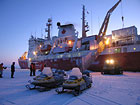

 | |||||||||||||
|
|
Journals 2007/2008Jason Pavlich
December 26, 2007 Position 71° 13.489' N 124° 24.892' W The day kicked off with an ice team meeting at 9 am. The meeting was attended by all of the teams that will require sampling off the ship (on the ice). It was announced by Tim Papakyriakou, chief scientist for Leg 5A, that this flow will be our home for the next 6-7 days. The ice sheet we are in is elliptical in shape, roughly 2 1/2 km long. The Amundsen came to rest yesterday about 2/3 of the way towards the center. Sampling must be conducted in a pristine environment so the stations and sites must be very organized. Ice coring, surface water and snow sampling, light measurements, net deployments, and temperature readings must all be coordinated, areas will be set aside for all of the sampling to take place. Paths must also be established and marked for foot and snowmobile traffic so as not to contaminate sites. It is most convenient to conduct the sampling as close to the ship as possible but then there is the risk of contamination from the ship. Surface current readings will be done to ensure that none of the stations are located either downwind or down current from the Amundsen. It appears from the plan that the most remote site will be the snow sampling one at 1.2 km from the ship. There is very little snow, only about 2 cm on the flat ice near the ship, so in order to sample rougher ice must be located that can hold the snow. Once the sites have been established, visits to the sites must be coordinated in groups to conserve gas and for security reasons (polar bears). The meeting was adjourned and smaller groups immediately convened to figure out how to make the most efficient use of their time on the ice. Vladimir Shevchenko, a Russian research scientist from the Shirshov Institute of Oceanography in Moscow, asked me if I would like to join him later (maybe not today) on a snow sampling. I accepted his offer. For the most part the scientists here have a fairly limited audience for their work, so everyone is more than happy to share their knowledge and ideas with me. At 1:30, I started layering up to head outside on the ice. The wind was moving at around 13 knots, giving a wind chill factor of -42°C (-44°F). By 2 pm I was on the starboard side with the other scientists ready to head out. Because we would be collecting ice cores over a wider area, two crew members with shotguns accompanied us. We walk slowly down the stairs, through the cage (to prevent bears from making their way onboard) and onto the ice. Snowmobiles were used to bring the corers, coolers, and other equipment over to the staked area that was to be sampled about 150 m from the ship.
The corer is a hollow tube about 1 m long with a set of blades on one end and a t-shaped handle on the other. It was positioned vertically above the spot and pressure applied to the top while twisting in a clockwise motion. After what seemed like and endless process of spinning the corer, it broke through to the water below. The corer was then lifted up and the ice cylinder removed and bagged. While coring, people would constantly offer to help because the longer you stood around, the colder you got. Wojciech, Monika, Laura, Amanda, and I took turns on the two corers collecting 2 ft long samples. In three hours time, about 20 cores were taken, packed in coolers and brought back to ship.
There was ample light when we started our coring, but it did not take long to fade. The moon quickly made its way over the northern horizon, but reappeared soon after to head back across the sky. While the moon was gone, I got my first glimpse of the northern lights. Green streaks made their way in and out of the big dipper almost directly overhead. I could do nothing but stare at the sky for several minutes until the cold drove me back to corer.
A warm dinner never tasted so good. Afterwards, a science meeting was held in the officer's lounge to discuss the schedule of events for the next day. It looks like tomorrow will be split between lab and ice. Sergey Shutilin then kicked off the weekly science seminars with a lecture on the history of Russian Arctic expeditions and their recent contributions to the International Polar Year cooperative. Aside from the graphs being labeled in Cyrillic, it was quite informative and well-received. It is 10 pm now and I am having a hard time staying awake. The cold sucks out your energy and leaves you tired and worn. This is the first day I really experienced the Arctic. I look forward to the next. |
||||||||||||



